Streamline Your Product Roadmap Decision-making Process with Jira Product Discovery
An introduction to the recently released Jira Product Discovery tool and its potential relevance and utility for your team.
In what scenarios would this solution offer users a valuable benefit?
We’re all familiar with the process of decision-making. We’re also all aware of the challenges that can arise when a decision, such as by product management, must accomplish several stakeholders’ requirements, has significant implications for a large number of people, or involves substantial financial investments.
It’s crucial for a company to make well-informed decisions about the evolution of its products and services. If the decision-making process is ineffective and results in unsatisfactory outcomes for the company and its customers, this can ultimately lead to the company’s failure.

There are a number of tools and techniques that can be employed to facilitate the decision-making process. The following examples illustrate the various use cases offered by the PMI community.
- Critical decision-making skills for project managers
- Project management decision making
- Product management practices
In particular, among the process factors defined by Disciplined Agile® Product Management (see link above), there’s one that’s particularly relevant:
“Evolve vision: Product managers will work closely with stakeholders, and in the case of new products/solutions potential stakeholders, to understand their needs. The goal is to develop roadmaps for individual products, product lines, and for the business itself. These roadmaps describe the current vision for the near term, intermediate term (3-12 months), and long term (one year or more) with less detail the further out in time the roadmap goes. These roadmaps help the product managers to guide their prioritization decisions and provides input into the planning activities of other efforts (such as the Enterprise Architecture and Portfolio Management activities)“
A well-designed decision-making process should yield outcomes that satisfy both the practical and emotional needs of stakeholders. So it’s crucial to establish a collaborative and participative approach to defining the next evolutionary steps of the product/service in order to achieve the concrete practical and emotional involvement of stakeholders. By sharing and making as specific as possible the choices made directly on a roadmap that everyone can access, stakeholders will be able to contribute as true collaborators rather than as passive spectators.
So if you want to make your product or program decisions better, are you prepared to implement a structured process for decision-making? Are you fully aware of the advantages and the effort required to make this system work? This article gives you insight into the potential benefits of adopting a tool that can facilitate communication among stakeholders and provide objective guidance on key parameters, helping you manage this complex process.
Meet the new Jira Product Discovery tool
Jira Product Discovery was developed primarily to meet the needs of product managers, product operations teams, and program managers. It’s a suitable choice for any team that engages in ongoing product discovery and collects feedback and data to inform their roadmap.
It enhances the collaboration between users/stakeholders (contributors) and team members (creators) who manage the final decisions on what to do or not do (developing a product, service, new project, etc…)
In Jira Product Discovery (JPD), users can invite colleagues to collaborate in two different roles: Creator and Contributor. The Creator role allows users to create and manage ideas, views, and projects, while the Contributor role enables them to add insights, comments, and reactions, and, if permitted, create ideas. Here you can see a summary of the respective roles’ capabilities and limitations:

A JPD project is a dedicated space for the collection and organization of ideas, insights and roadmaps for an individual team or a product. It’s the place where uncertain work is managed and addressed by evaluating ideas, validating them with insights and testing prototypes.
For those already familiar with Jira, a JPD project is conceptually similar to a Jira project (it represents a collection of issues), but with different functionalities due to the different nature of the relative scopes for which they were designed.
JPD is primarily for managing ideas/suggestions and the related process of analysis, approvals and comparisons with other competing ideas/suggestions, while Jira is for managing the work to be done.

What’s the best approach?
Given that, at the time of publishing this article, JPD is a new product still in the process of being consolidated and incorporated into the Atlassian cloud products’ universe, our recommendation for those just starting out is to focus on the use cases provided by Atlassian itself that are currently available in the JPD Handbook.
The handbook is a continuously evolving resource that is already rich in content and key insights. A summary of these key points is provided below for your reference.
From a general standpoint, we can approach the subject of managing our product decisions by first defining the idea’s life cycle, which we represent by macro stages as follows:

- Wonder: Focus on the problems or opportunities, whom they’re for, and their importance
- Explore: Iterate on potential solutions until one that’s found that is validated with customers
- Make: Build the solution and iterate on it until it satisfies the needs of enough customers
- Impact: Launch, measure results, and keep improving the solution until satisfied with the outcome
It should be noted that these stages are not to be considered as sequential; rather, they are to be regarded as iterative.
Therefore, it’s expected that any new idea submitted to our product backlog will progress through these stages on one or more occasions. After that, it will either be temporarily frozen in a “parking lot”, or ultimately completed or abandoned.
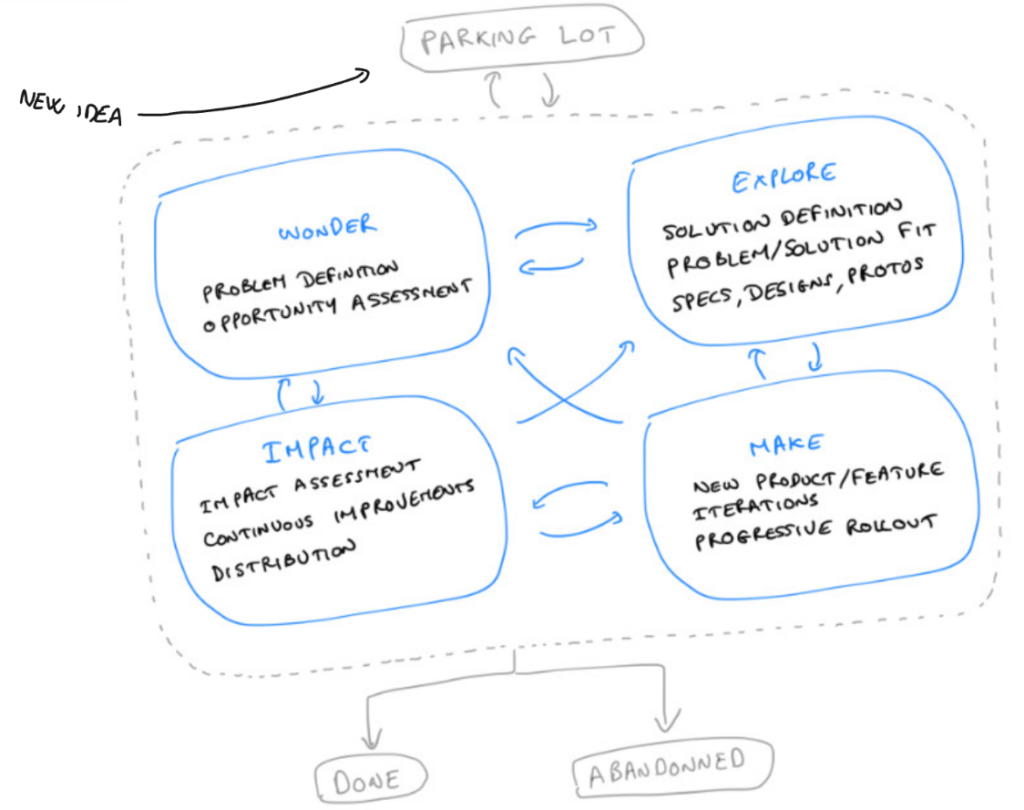
Please be aware that there is an alternative way to conclude the life cycle of an idea. JPD also provides the option of ‘merging’ two or more ideas, thus preventing the need for the management of potential duplicates in the project.
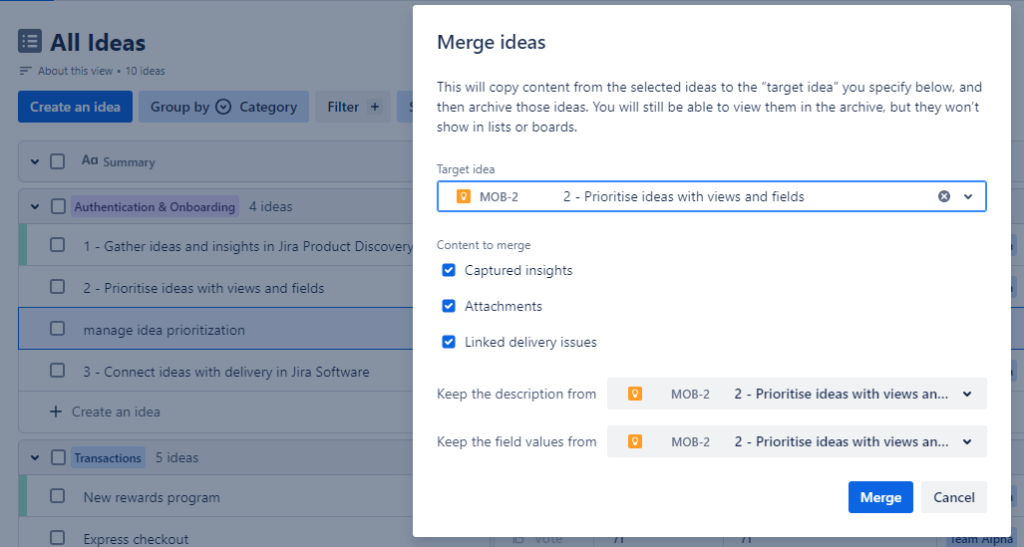
Create ideas to centralize all your product initiatives
Ideas are at the core of Jira Product Discovery. They are the units of work in Jira Product Discovery projects. An idea can represent a user problem, a product feature, an opportunity, or a solution. You can collect all your product’s ideas in Jira Product Discovery to keep them centralized in one place.
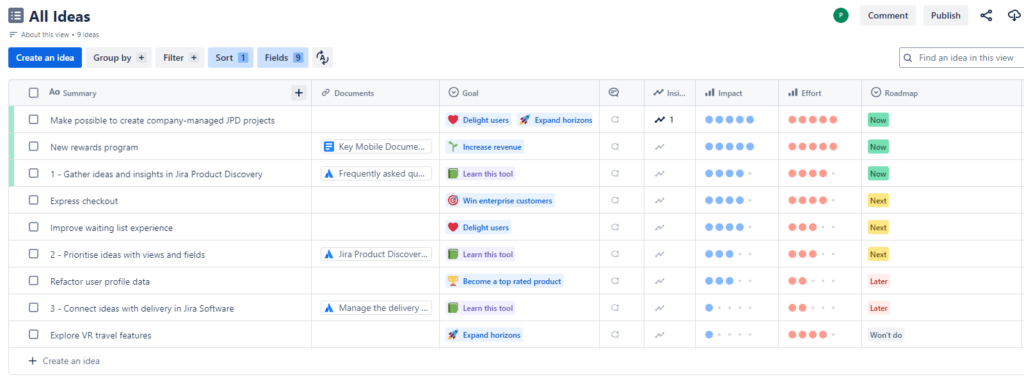
“Ideas” is used in JPD to describe product ideas and more. Product backlogs can contain ideas of different shapes and levels of granularity. However, it’s important to agree on definitions. Otherwise, your product backlog will become unmanageable.
Within the JPD you have the option to define which measure you prefer to weight ideas. We suggest you start by using the following three levels, which are currently in use and documented by the JPD team: boulders, rocks and pebbles.
- Boulders represent a large investment with a potentially very large upside, but also often with high uncertainty: a big new bet, a new product pillar, or a large engineering project
- Rocks represent medium-sized investments with less uncertainty – a new feature, new onboarding experiments, or a feature redesign based on feedback
- Pebbles are small investments and are usually relatively straightforward: small UX improvements, and fixing “paper cuts” – issues with the product that aren’t blockers but are just annoyances.
Gather insights to collect data points supporting ideas
You can use insights to capture users needs: snippets from customer interviews or user research links to keep tickets or sales opportunities, links to specific product analytics dashboards using the Chrome extension, or messages from Slack or Teams.
You can then prioritize your ideas using the collected insights and their impact.
It’s crucial to highlight that contributors, in addition to create new ideas, also have the chance to provide valuable insights that can enhance existing ideas.
They are the ideal candidates to contribute to the refinement of an idea, given their privileged point of view. If those responsible for managing the product are able to collect this kind of feedback from users, it represents a very positive starting point.


Including relevant insights during a prioritization session increases decision process effectiveness. Without them, decisions are often made on individuals’ intuition, subjectivity, or by the most senior leader, with no solid foundation in collected data. Indeed, this will consequently impact the prioritization phase, which we’ll discuss in detail below.
You can use Jira Product Discovery in collaboration with support, sales, research and feedback management solutions. It should be noted that not all of these will require direct access to JPD, so it’s recommended to set up multiple channels to gather insights continuously, as illustrated in the following scheme taken from a JPD team use case, in order to collect as many valuable insights as possible and from different perspectives.

Prioritizing ideas
Prioritization represents a significant challenge and critical factor in the success of any product team. Product managers must manage conflicting priorities and make informed decisions that balance various aspects such as immediate business needs, longer term strategy, customer needs, competition and changing market conditions . One of the most crucial skills for a product manager is the ability to prioritize effectively.
Inadequate prioritization can lead to conflicts and poor outcomes. Discussions may result in conflicting opinions, or decisions may be driven by subjective intuitions from key stakeholders or customers.
There are a few ingredients to help set this process up for success, including:
- Balance investments over time across all dimensions important to the success of the product: user requests, sales opportunities, support problems, strategic bets, metric movers, etc. Don’t just ship new features.
- Make the process collaborative: include the whole product team as well as all stakeholders who have insights into what the business and customers need – not dictated by leadership or done in isolation by the product manager.
- Leverage data and insights: prioritize based on qualitative and quantitative insights that come from a continuous product discovery practice – not based on gut feel or loud opinions.
- Work continuously on what you learn along the way – not once a year in a “big bang” roadmapping effort.
The following screen illustrates an example of a list of ideas that have been automatically sorted according to a specific parameter, calculated from other fields in the idea (column ‘Fx Customer impact’).

To achieve a more balanced outcome on the different product aspects, it’s recommended to apply the RUF framework to analyze ideas. This framework categorizes ideas into three distinct categories which we will use to inform our decision-making process. The approach is to view your product roadmap through these 3 distinct categories, each with a dedicated budget allocation for the elements that are crucial to your product’s success. The 3 categories are:
Reliability: Users want an accessible app that works well and doesn’t lose data. Building trust takes time, but a single data loss event or security breach can destroy it quickly, particularly in customer relations. Hence, focus on resolving any issues that arise ASAP, and consider investing in infrastructure to prevent interruptions.
Usability improvements: Many products already have lots of features, which make them challenging to develop. Your plan must include a budget for maintaining the current feature set. Prioritize improving highly used features and removing unused ones. Educate users about new features and optimize conversions.
New Features: Once the necessary infrastructure has been established, new features can be developed.

To conclude the topic of prioritization, we recommend that you keep reviewing how you prioritize: it’s crucial for getting good results that you regularly review not only your priorities, but also how you prioritize!
Roadmapping
A roadmap is a tool for discussing and prioritizing product ideas.
It also facilitates communication of these priorities, enabling other teams to fulfill their responsibilities. There’s no correct way to create a roadmap, but it should definitively represent a range of tasks related to collaboration, communication, and evaluation. They often involve multiple individuals and external stakeholders.
There are a set of common attributes that facilitate the creation of effective roadmaps:
- Succinct: They fit in one page.
- Updated: Since people rely on the information to do their jobs!
- Nouns and concepts that everyone understands: Concepts are easy to grasp and clearly explain priorities, rationale, and the big picture.
- Clear priorities: Clearly articulate priorities and explain the rationale behind them.
- Outcome/goal-based: Clearly outline goals and priorities.
- Honesty and making the level of commitment clear: Focus discussions on relevant issues, and setting realistic expectations.
It’s very important to understand that a single product roadmap is insufficient for effective product management. It’s essential to have multiple, tailored roadmaps for different stakeholder groups.
JPD’s dynamic views are automatically updated in real-time, eliminating the need for users to track multiple roadmaps. JPD’s self-service roadmap option provides users with tailored information, enabling them to access the data they require and interpret it accurately. This will considerably ease the work for the product manager and their team.
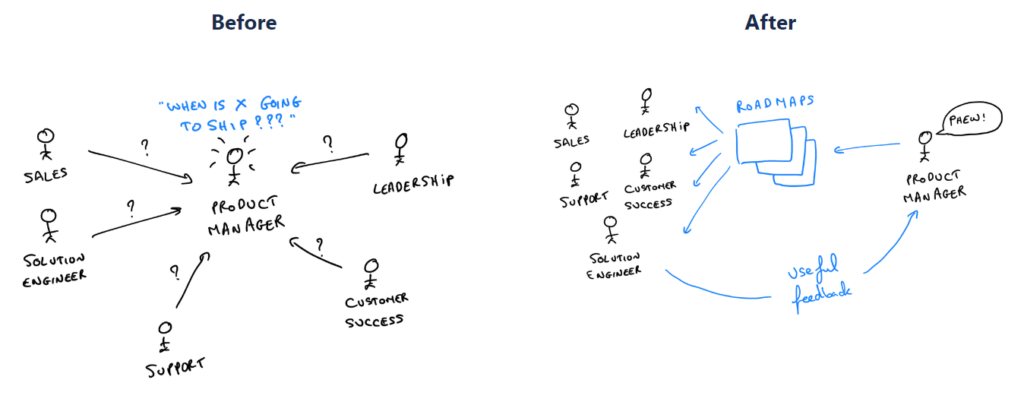
You can create and manage different types of roadmaps according to the specific requirements of the individual or group involved. As I said earlier, there is no single roadmap that can be applied to all parties engaged in this process. The scope is to provide each of them with a roadmap that contains the elements they can understand and are interested in.
Some potential examples are as follows:
- Outcome-based roadmap: Effective roadmaps clarify desired outcomes and offer a strategy for achieving them.
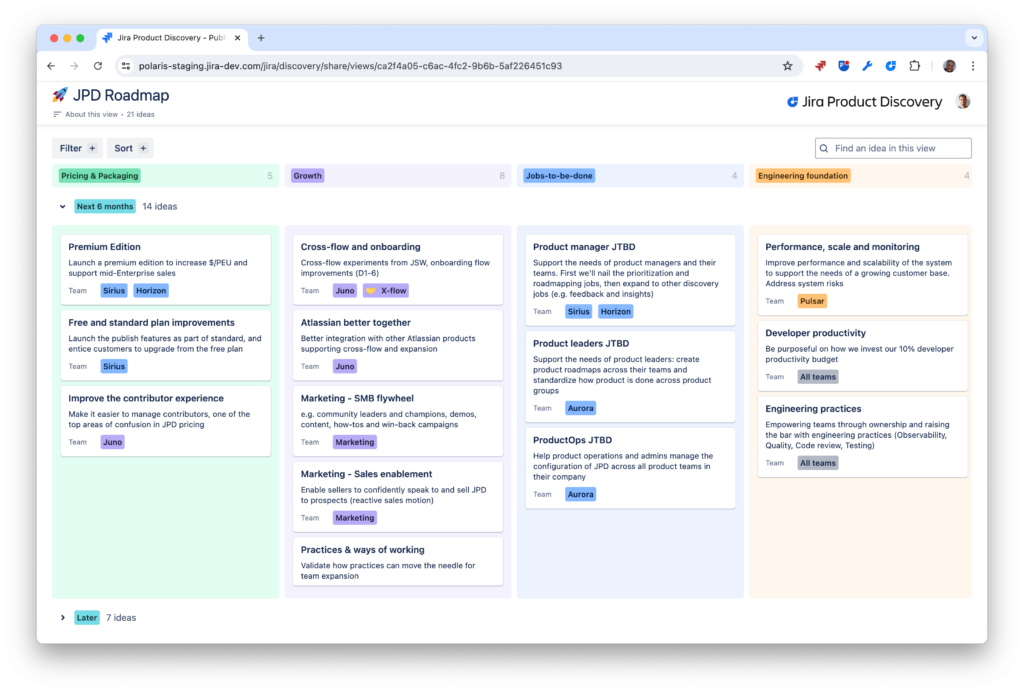
- Now/Next/Later roadmap: aligns team members on proposed investments, product initiatives and high level activity sequencing. It allows discussions on outcomes, uncertainty and capacity without getting bogged down in delivery specifics.
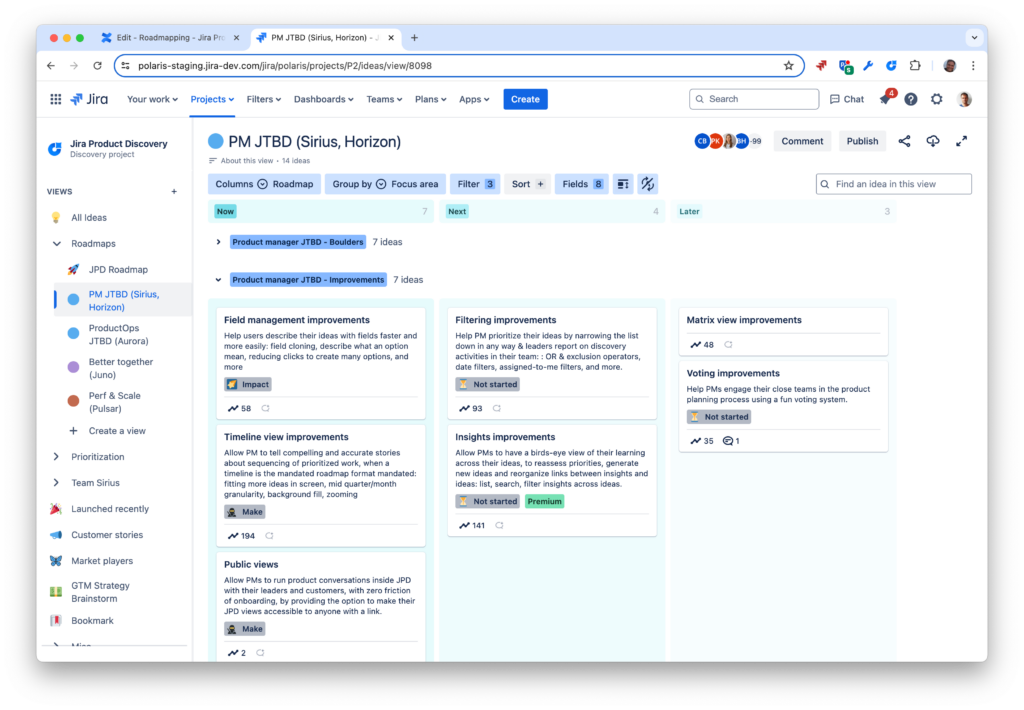
- Time-based roadmap: Gantt charts aren’t useful for product roadmaps. They focus on the output, not the reason for the project. Time-based roadmaps can be useful for sharing information with other teams and marketing when the level of commitment is already clearly defined.
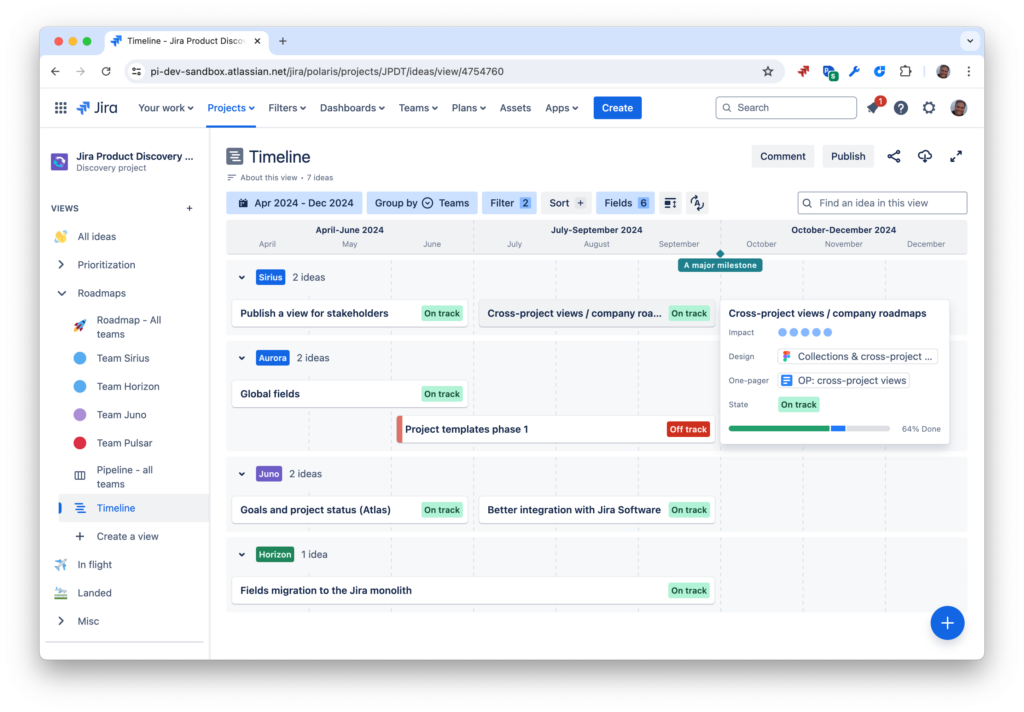
Conclusions
In conclusion, a company cannot succeed if it doesn’t have effective decision-making processes in place for the development of its products and services. Even Atlassian has recognized this need and has developed a dedicated solution, integrated directly into Jira, to address it.
In this brief overview, I’ve tried to convey the logic behind this product and the underlying philosophy that should be applied when using it.
In light of the above, we can only support a solution that will streamline decision-making processes within the Jira system. The approach that JPD is taking at this early stage is undoubtedly the right one. Following a trial run, we are pleased to report that the results are very encouraging.
However, given that this is a new product that has only recently been released from beta, there’s still considerable opportunity for growth and improvement. As an example, it should be noted that at the time of writing, it’s not yet possible to manage company-managed projects in JPD, or to utilize the Teams already present in the Atlassian plan.
However, these are all features that we expect to be introduced gradually in the near future, potentially coinciding with updates to other Atlassian products, such as Jira itself. In the meantime, we would like to take this opportunity to express our positive sentiments towards this product and encourage you to delve more deeply into its features and follow its future developments (here).
These Solutions are Engineered by Humans
Did you find this article interesting? Does it match your skill set? Our customers often present us with problems that need customized solutions. In fact, we’re currently hiring for roles just like this and others here at Würth Phoenix.






